8 Best Ant Killers for Lawns - How to Get Rid of Ants in Your Yard
Written by Ivy
Dec 14 2022
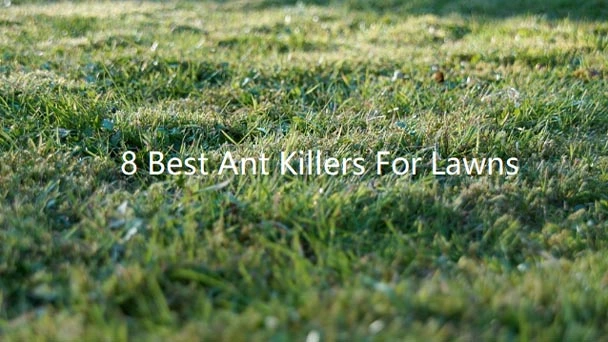
It is safe to assume that there are more ants nearby once you spot one in your home. You can use this review to find the Best Ant Killers For Lawns that are best for you. The items mentioned in this article are offered at a number of brick-and-mortar shops, neighborhood home improvement stores, and online merchants.
Asking homeowners to list the pests that give them the most trouble is likely to include one niggling little insect that invades and colonizes their yard in large numbers: ants. Here are some Best Ant Killers for Lawns to get rid of ants in your house and yard so you can act if there is an ant invasion.
Best Ant Killers for Lawns Overview
- The Best Liquid Spray Ant Killer: Ortho Ready-to-Spray Home Defense Insect Killer for Lawn & Landscape
- The Best Granular Ant Killer: Ortho Home Defense Insect Killer Granules
- The Best Plant-Based Ant Killer: Orange Guard 101 Home Pest Control Gallon
- The Best Liquid Ant Bait Stakes: TERRO Outdoor Liquid Ant Bait Stakes
- The Best Diatomaceous Earth Ant Killer: Harris Food-Grade Diatomaceous Earth
- The Best for Targeting Fire Ants: Ortho Fire Ant Killer Bundle
- The Best for On-Demand Spot Treatments: TERRO Outdoor Ant Killer Spray
- The Best Lawn Food With Insect Control: Scotts Turf Builder SummerGuard Lawn Food with Insect Control
1. Ortho Ready-to-Spray Home Defense Insect Killer for Lawn & Landscape
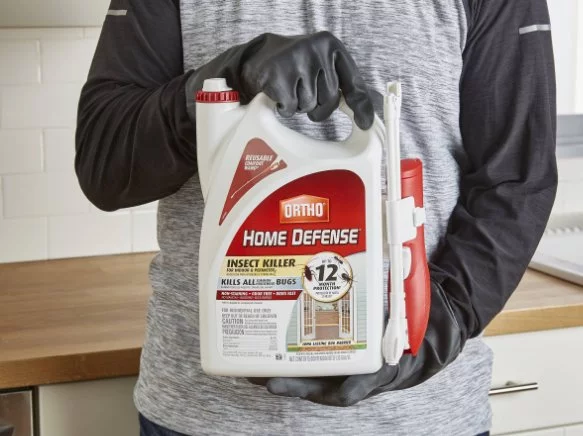
- Highlights: cost-effective, 1-step application, effective for up to 3 months
This liquid insecticide is a great choice for those on a tight budget because it only requires one step of the application process. For easy spray application over large areas or to create a barrier around your lawn, the bottle of concentrated solution connects to a regular garden hose. Although it is advised to reapply after heavy rains, the bifenthrin-based formula begins working within minutes and is effective for up to three months. As you attach the hose, keep in mind that you'll need to be careful to prevent spills. People and pets can safely walk and play in treated areas after the solution has dried, according to the brand, but be sure to follow all instructions closely.
A reviewer wrote: "It was necessary to exterminate some ant hills. Additionally, since our fence line is next to a farm, I use it on its reverse side. Definitely keeps the bugs away from our yard!"
2. Ortho Ready-to-Spray Home Defense Insect Killer for Lawn & Landscape
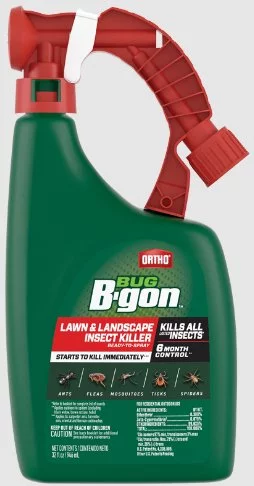
- Highlights: cost-effective, 2-step application, no chance of spills, lasts for up to 3 months
These exterior granules can be sprinkled on lawns, around grassy or landscaped yard perimeters, or directly on ant mounds. This is a two-step process, albeit a relatively easy one that also eliminates the possibility of liquid spills, in which you must water the granules with a hose or sprinkler after application. Bifenthrin is the main component, and just like the prior option, you must wait until the area is completely dry before allowing people and pets to come into contact with it. It can be applied as needed, but it loses its potency after three months and may need to be reapplied after a lot of rain.
A reviewer wrote: "I tried a variety of products in an effort to eradicate a sizable ant mound on my lawn that kept returning despite treatments with other products. This one worked."
3. Orange Guard 101 Home Pest Control Gallon

- Highlights: non-synthetic ingredients, 1-step application, also works as a repellent, lasts for up to 3 months (according to a reviewer)
D-limonene, a substance derived from citrus peels that is toxic to ants and other insects, is the active component in this plant-based lawn ant killer and repellent. The pre-diluted formula is safe for use around people and pets (although you'll want to allow it to dry as essential oils like d-limonene can be toxic to dogs and cats), and the included nozzle allows you to spray it directly onto mounds or the lawn for on-contact ant extermination — no hose or watering required. This alternative has the added benefit of being an ant repellent due to the orange scent it leaves behind, which may help deter ants in the first place. The fact that it must be reapplied after rain and the higher cost may prevent it from being a viable choice for tackling large areas.
A reviewer wrote: "I sprinkle a small amount of Orange Guard at the slab's base all around my house during ant season. Wherever ants are entering the house, both inside and outside, I also spray it with it. It also kills them, but it works best as a barrier because ants detest it."
4. Orange Guard 101 Home Pest Control Gallon
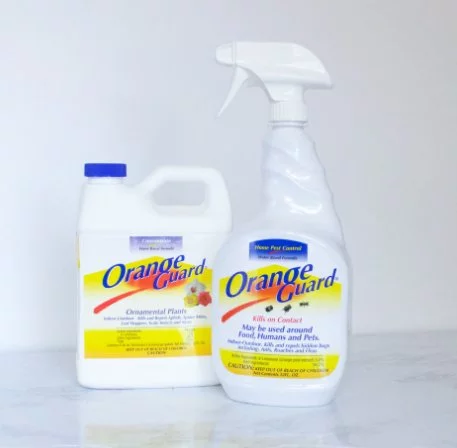
- Highlights: low-effort/no-mess application, cost-effective, rain-tolerant, non-synthetic ingredients, lasts 2 to 3 months (according to reviewers)
These outdoor bait stakes are a great choice if you're looking for minimal mess and low-effort application. The liquid bait attracts the ants, who then take the mineral powder borax, which kills by dehydration, back to their colonies. The stakes can be anchored anywhere you like, including next to ant hills or colonies and along the edge of your lawn, allowing you to target particular areas. A clear panel on the side of this two-pack lets you know when it's time to replace the stakes and gives you ample yard coverage thanks to its total of 16 stakes. Another nice feature is that the stakes can withstand rain, so you won't need to replace them after a storm, and users say they last for about two to three months.
This method should be used with caution if you have pets or young children because they could become curious about the stakes or think they are toys.
A reviewer wrote: "The ants have disappeared, and it's so easy to use! Over the past few years, I have attempted to get rid of a sizable ant hill in my yard. The ants are gone after purchasing this product and using it exactly as instructed!!!!"
5. Harris Food-Grade Diatomaceous Earth
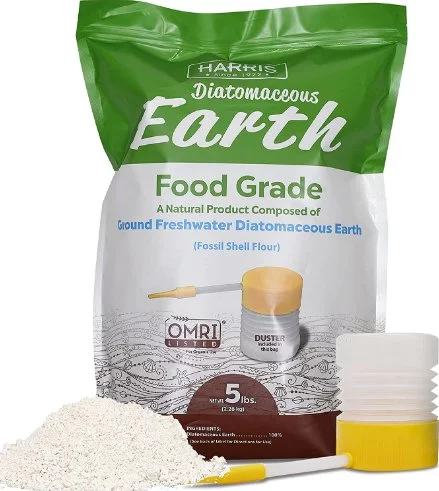
- Highlights: highly rated, 1-step application, non-synthetic ingredients, lasts 1 to 6 months (according to reviewers)
This diatomaceous earth, which is a naturally occurring ant and insect killer made from fossilized freshwater algae, has a 4.7-star average rating on Amazon after 7,000 reviews. By absorbing moisture from the insect's body, the fine, powdery substance causes dehydration and eventual eradication. Although you should wait for the dust to settle, it can be sprinkled directly onto ant mounds or across grass without endangering people or pets, according to the brand. Diatomaceous earth may not be the best choice for humid climates because it is powdery and easily washes away. For best results, it should be reapplied after rainfall. Anyone looking for something organic and non-synthetic should consider this ant killer powder because it is registered with the Organic Materials Research Institute, an independent nonprofit organization that specializes in verifying organic materials and ingredients.
However, they also discovered that the included applicator makes it fairly simple to apply. Reviewers have noted that it can be a little messy due to the formula's dusty nature (and a mask is recommended during application).
A reviewer wrote: "Excellent for controlling bugs and ants. For lawn pest control and in an organic garden, I use it outside our house. Since it seems to be a much finer powder than others, it does tend to get on my clothes more than other diatomaceous earth products I've used in the past. All three bags I ordered—the powder duster/applicator—were delivered. They work great for dusting garden plants like tomatoes, but I find that they release too much powder into the air for routine applications of pest control on lawns. The brand is superior to others I've purchased in stores and on Amazon, and I would definitely recommend it."
6. Ortho Fire Ant Killer Bundle
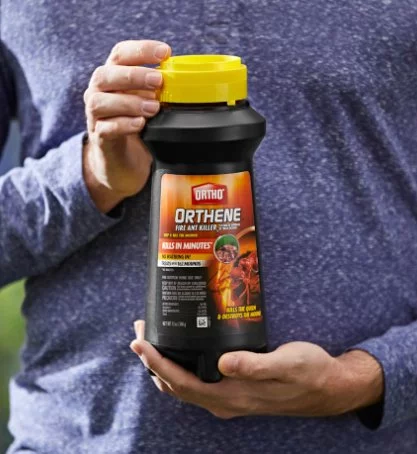
- Highlights: multi-step application/approach, lasts for up to 6 months
Fire ants are particularly difficult to eradicate and can bite both humans and animals in painful ways. In as little as 15 minutes, this combination of powdered ant killer and granules begins to kill fire ants, and for up to six months, it prevents the formation of new mounds. In addition to the granules having a spreader for simple application across the lawn, the powder can be used directly on ant mounds. The granules will need to be lightly watered, but make sure to let everything dry completely before letting animals or people out into the yard. The potency of the active insecticide, acephate, gives this fire ant killer its potent smell.
A reviewer wrote: "The product is fantastic. On my desert sage acreage, I had a lot of fire ant mounds, and nothing I could buy off the shelf that was advertised as an ant killer had any real effect on the fire ants other than to really irritate them. [...] When I checked 24 hours after sprinkling the ortho product on two sizable mounds that resemble miniature volcanoes, there was absolutely no activity. It has now been two months since the application of the ortho product, and there are still no signs of any fire ants at or around the mounds."
7. TERRO Outdoor Ant Killer Spray
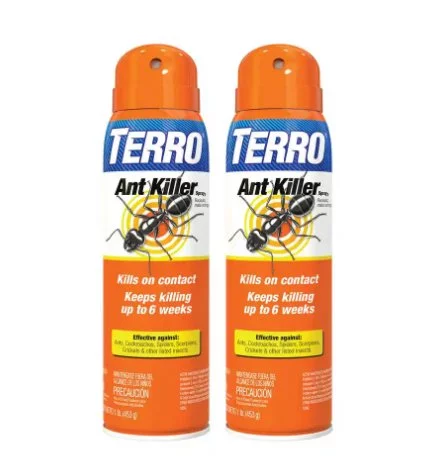
- Highlights: cost-effective, easy one-step application, good for spot treatments and small areas, lasts 2 to 3 months (according to a reviewer)
This aerosol spray ant killer lets you target ant mounds, cracks in hardscaping, and the perimeter of your home if you're only dealing with a minor infestation and want quick, simple results. It uses the permethrin insecticide, which has a 10 to 15 foot range and is secure to use around both people and animals once fully dried. It's great for spot treatments and gets to work right away, but it might need to be reapplied after rain because it's ineffective for widespread ant eradication.
A reviewer wrote: "I give this product five stars because it works incredibly well to zap the ants and their nests in my yard."
8. Scotts Turf Builder SummerGuard Lawn Food with Insect Control
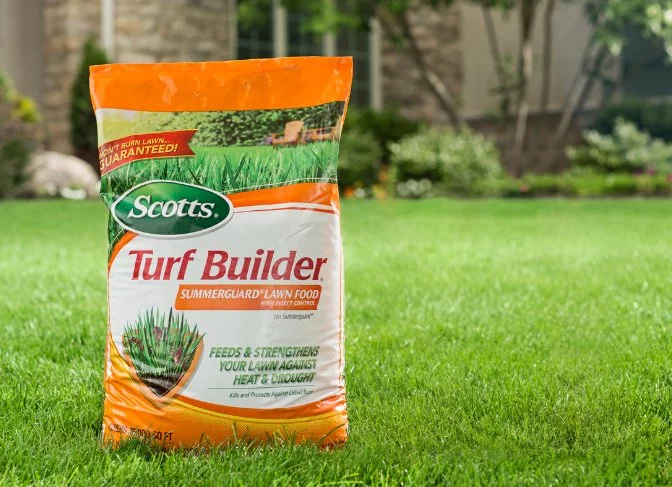
- Highlights: fertilizes lawn and increases drought resistance, 2-step application
This lawn food improves the grass's capacity to absorb water if you reside in a region that is prone to drought and extreme heat, and it also contains trace amounts of bifenthrin to reduce ant and insect populations. Before pets or people come into contact with it, it should be spread out using a spreader like regular lawn food, watered in with sprinklers or a hose, and then allowed to dry.
A reviewer wrote: "Since we had ants in our yard, we decided to try this product despite our initial skepticism. In addition to being an excellent fertilizer, we have finally found a solution to the pest problem in our lawn. We thought the price was high, but when you factor in the cost of pest control, it turns out to be a great deal. The quarterly spraying by our pest control company worked less well than this."
How to Choose the Best Lawn Ant Killer for Your Yard
There are a ton of ant killers on the market, but only some of them actually do what they claim to do.
Which product would work best on your lawn, I ask? Which will be most efficient and quickly resolve your issue?
Pay attention to the following elements to reduce your options. Additionally, you might want to become familiar with the blunders that customers commonly make when purchasing ant killers (I'll explain those as well).
What to Look for When Buying Lawn Ant Killers
The most crucial points to consider when buying lawn ant killers are:
Type of Ant
Do not purchase an ant killer right away. Identifying the particular ants that are destroying your lawn should be your first step.
You can then look for a product that caters specifically to them. Here are the most common ant species that cause lawn destruction:
- Odorous ant – this ant gets its name from the foul smell it produces when it's squashed. More importantly, its resilience enables it to withstand mild ant treatments. Both indoor and outdoor environments will support odorous ants; they don't have particular habitat preferences. Because of this, you must act quickly to stop them from entering your home once you spot them on your lawn.
- Carpenter ants – these ones come in a bigger size than other ants. The size of the worker ants is between 6 and 12 mm, whereas the winged males can grow up to 20 mm in length. However, I have a problem with their powerful mandible jaws. They employ them to bore into wood. Beware of these ants if your yard contains any wooden structures, especially those made of wet wood.
- Army ants – another ant species that's destructive to lawns is the army ant. Army ants, as their name suggests, prefer to move in big groups. These are of particular concern because they prefer to feed on foliage, which means they can quickly destroy your turf grass and any vegetation growing in your yard.
Type of Ant Killer
Determining the kind of ant killer to use is the next thing you should do. These items can be divided into two groups: bait and kill-on-contact.
- Bait – this insecticide works by appealing to the ants' natural instincts. It specifically makes use of the fact that ants adore sweet things, including sugar, honey, and other sweet treats. As a result, the majority of baits include a piece of food with a tasty or appealing scent to attract ants. They also include slow-acting ant-killing ingredients. This gives the worker ant plenty of time to consume and transport any leftover bait back to the colony before the ingredient starts to work its full effect. This makes it possible to focus on the colony as a whole.
- Kill-on-contact – as implied in the name, this product contains fast-acting ingredients that kill these creatures on the spot. In contrast to bait traps, which can simply be left out to work on their own, the chemical must come into contact with the ant for it to be effective, so you're looking at taking on more responsibility for a good application.
Application Technique
The way lawn ant killers are applied also matters. This aids in determining whether you need to purchase extra tools, such as a spreader or sprayer.
The application methods available are:
- Bait station – In this case, all you need to do is to set the trap within your lawn. It must have an ant poison mixture and a bait, which is essentially food that attracts ants. I appreciate that this is a set it and forget it strategy. All you need to do is set up the bait station in an ant-populated area, and it will take care of the rest. The disadvantage is that some beneficial insects might also be drawn, making them collateral damage.
- Sprays – Some ant killers come in liquid form. It can be sprayed directly onto the creature to instantly kill it. You could also use it around your home's perimeter and at common entry points. When you spray the ant killer, a residue is left behind that kills any ants that come in contact with it. This ultimately means that you will require a spray bottle or other spraying device to carry out the extermination. The only thing you might need is a garden hose, which you most likely already own, since the liquid products I suggest on this page are ready to spray.
- Granules – Granular ant killers are meant to be scattered all over your lawn. Some of these products require you to water your lawn in order for the ingredients to take effect. They leave behind a residue after dissolving in the water that kills ants instantly when they come in contact with it. Granular ant killers must be spread with a spreader, but the procedure is simple and well-known.
- Dust – Ant killers can also come in powder form. It either consumes or directly contacts the target creature, killing it. The best option is to use dust ant killers to either target specific anthills in one area or to establish a protective perimeter around your entire property.
Active Ingredients
Once you've chosen the kind of ant control you'll employ, look for the essential component. The most effective active ingredients eliminate ants without harming your lawn or endangering human health.
Highlighted below are some of the most common active ingredients:
- Deltamethrin – this ingredient is typically found in kill-on-contact ant killers. Once consumed, it disrupts the ant's central nervous system, resulting in instant death.
- Borax – this element is used in ant killers with a delayed on-set feature. This indicates that it requires time to take action. The benefit is that it gives worker ants enough time to return to the colony and distribute it to other ants. Many baits contain it.
- Bifenthrin – is another kill-on-contact poison. This indicates that for it to work, it must be in close proximity to the ant.
How to Stay Safe When Handling & Applying Insecticide
When purchasing an ant repellent, always make sure the EPA has approved the ingredients. By doing so, you can determine whether it is secure to use around children and animals.
Additionally, you should do your research and comprehend how long you must stay away from the treated area after application.
The majority of ingredients used in these products, thankfully, are poisonous only to ants and a few other insects, not to humans. To reduce your exposure to them, it makes sense to take safety measures.
Here are some of the measures I take before applying a lawn ant killer:
- Wearing protective gloves, long pants, and long sleeves,
- Wearing eye protection and spraying away from my eyes (be mindful of wind direction), and
- placing ant bait stations out of children's reach.
Things to Avoid When Buying Lawn Ant Killers
Are you having no luck getting rid of ants? You're probably making one of these mistakes with ant killers:
- Failing to identify the ant species first – before anything else, figure out the specific ants attacking your lawn. The product you produce will be useless against the ants in your yard if you skip this step.
- Not buying the correct amount of the lawn ant killer – another mistake that buyers make is buying an incorrect amount of ant killer. You should determine the area of your yard in order to prevent this. This will enable you to calculate the precise quantity of anticide you need to apply to the entire lawn. You can find a free tool I have to help you with that right here.
- Relying solely on ant killers – ant killers offer a fairly quick solution to your pest problem. The underlying issue is not addressed, though. To find out what initially attracted the ants, you should also take a closer look at your yard. By doing this, you can save time and money by preventing further ant infestations.
Frequently Asked Questions
How Do You Use An Ant Killer?
Depending on the kind you have. Place them in the corner of a room where ants have been spotted as bait. Spray the killer directly onto an area that is infested or onto the insect itself if using a spray. Read the manufacturer's instructions carefully before using your killer because they will contain additional information specific to your product.
What's the Best Way to Get Rid of Ants in My Kitchen?
Target the entire colony if you want to get rid of ants in your kitchen and prevent them from returning. Bait works best for this because it is returned to the colony by the other ants.
When Should I Contact An Exterminator?
If you use the right ant killer frequently, you should be able to get rid of even bigger ant infestations. But if the issue persists, it might be best to leave it in the hands of experts.
Latest Updated
- Benefits of Bugleweed - 7 Science-backed Health Benefits
- Bugleweed Dangers & Side Effects - Is It Poisonous?
- How to Plant Evergreen Trees - What You Should Know
- When to Plant Evergreens - Grow Guide for Evergreen Trees
- 12 Wonderful Evergreen Shrubs for Your Garden
- 12 Popular Evergreen Plants with Pictures for Beginners
- When And How To Prune A Lilac Bush Like a Pro
- How to Grow & Care for Lilac Vine (Hardenbergia Violacea)
- Japanese Lilac Tree (Syringa Reticulata) Care & Propagation Guide
- Shumard Oak Pros and Cons - What to Know
Popular Articles
- Winter maintenance of Antirrhinum Majus
- How to Grow Terminalia Mantaly Tree
- How to Grow and Care for Crossostephium Chinense
- How to grow Antirrhinum Majus in spring
- Peristeria Elata (Dove Orchid) Profile: Info & Care Guide
- Underwatered Snake Plant (Sansevieria Trifasciata) - Signs And How To Fix
- How to Care for Brazilian Jasmine Plant (Mandevilla Sanderi)
- How to Grow & Care for Graptopetalum Purple Delight in Summer
- Rosa Chinensis (China Rose): Plant Growing & Care Tips
- How to Care for Baby Sun Rose (Aptenia Cordifolia)